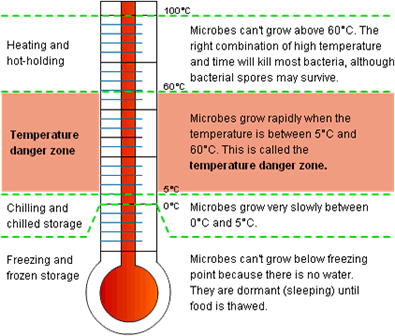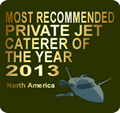| BlueSky Business Aviation News | |||||||||||||||||||||||
| . | |||||||||||||||||||||||
You as the flight attendant, flight crew, CSR at the hanger, FBO, or handler (including the scheduler/dispatcher) ordering the catering need to know these temperatures! More often than not, you can’t see spoiled food . . . Salmonella and e.coli have no physical signs, no smell and no taste in food. As I will discuss, there are specific guidelines that limit the time you can safely store food at these various temperatures. Time allowances for keeping food safe include not only the time you, the flight crew, have the food, but the time from kitchen production until consumption. How much time is required to get the catering to the aircraft? Is it being delivered warm where bacteria can thrive and multiply, or cold, under refrigeration and chilled at the food source prior to delivery? A commercial aviation caterer is aware of the additional abuse the food is exposed to and makes every effort to provide the longest possible time remaining for the food to remain safe when delivered to you chilled. The FBO or handler plays a role in maintaining the food temperature, whether loaded directly to the aircraft or dropped at an FBO for storage until you request the catering to the aircraft. Have you ever taken a look at the FBO/handler's refrigeration facilities? Are they monitoring and logging the temperature of their refrigeration? (and separating incoming catering - possibly loaded with tons of growing bacteria from time and temperature abuse? Is old catering or employee food touching anything in common with your food which can potentially make you ill? So sorry as I digress. Because of the design of the aircraft and the storage of catering on board, time and temperature can be one of your most critical problems, but also one that, with care, can be one of the easiest to solve. Bacteria are tiny so it takes a lot to make a person sick, BUT, temperature is one of the ways that bacteria can grow . . . and grow fast! NOW you will have enough to make you sick! Our objective as a food handler is to keep the bacteria from multiplying or to slow them down enough so they won’t harm your passengers or flight crews. Bacteria grow slowly when refrigerated, like a slow turtle crawling, but the bacteria have not stopped growing . . . even under refrigeration. Learn temperature controls
In 1951 safe temperatures were listed as 45° to 145°F; in 1969 they changed to 40° to 140°F. With all these revisions over the years we still need to allow for a margin of safety and take into consideration the imperfect environment we have in the aviation community. An additional note to consider for those of you cooking at home, at the hanger, or picking up from a restaurant (warm) and transporting the food, is that transportation time will count into that “safe” time so you could be allowing that bacteria to grow . . . and fast. Warm foods, plus a hot summer heatwave will push the catering you have into the danger temperature zone, allowing less safe time before consumption. So, a little nausea, vomiting, diarrhea, headache, adnominal cramping may follow. How much of a risk are you willing to take? Also consider the temperature of the aircraft interior and how early the food is pre-boarded into this hot environment. When the aircraft is hot, plan to load the catering at the last possible minute. Another consideration is whether the aircraft has a refrigerator, insulated Atlas boxes, a gasper drawer or other means to keep the catering refrigerator on board at or below 40°F/ 5 °C, which may vary slightly by a degree or two based on government regulations within a given country. Those individuals handling the food for aircraft consumption have a high responsibility here. There are numerous outside factors that you don’t have the ability to control on many levels Here are a simple rules to keep in mind when handling food for your flight crew and passengers to mitigate those risks.
Basic practices to follow are:
On an aircraft you are eating food made by someone else, and you trust them to keep the fod you are being served safe. Cooking and cooling foods correctly are the most important things you can do to keep your passengers and crews healthy. Caterers have knowledge of how to eliminate or decrease bacterial growth in order to assure maximum shelf life and food safety by cooking and cooling with trained individuals, are you trained to access and then mitigate the risk when preparing food on board or at home for a flight? Keep your food cold!
Let me introduce myself . . . My name is Paula Kraft and I am founder and President of Tastefully Yours Catering, an aviation specific caterer, located in Atlanta, Georgia for 35 years.
Currently I am an active member of the NBAA Flight Attendant Committee Advisory Board and the NBAA International Flight Attendant Committee, Women in Corporate Aviation, Women in Aviation International, National Association of Catering Executives, International Flight Catering Association, the International Food Service Association and the International Caterer’s Association. I have coordinated training programs and clinics for NBAA, EBAA and BA-Meetup conference attendees for over 10 years, created mentoring programs for caterers and flight attendants to broaden their aviation culinary skills, and to assist them in adapting to the unique challenges and constraints found in catering for general aviation. I recognize the need for training and have worked closely with flight departments, flight crews, schedulers and customer service reps at the FBOs to ensure that catering specific training provides information and skills necessary to reduce risk while assisting them in their job duties that include safe food handling, catering security, accurate transmission of food orders, and safe food production, packaging and delivery. I fell into aviation catering quite by accident. I was the in-house caterer and bakery supplier for Macy’s department stores in Atlanta when catering was ordered for a Macy’s customer which was soon to change my life. After the client enjoyed the catering provided, I was summoned to the client’s corporate office to provide several of the items delivered through Macy’s to the executive dining room. Within a week, I was providing food for the flight department and my first order was for the President of a foreign country (as I was too be told soon after). So, here I am, some 35 years later, still loving every minute of every day in aviation catering.
|
|||||||||||||||||||||||



